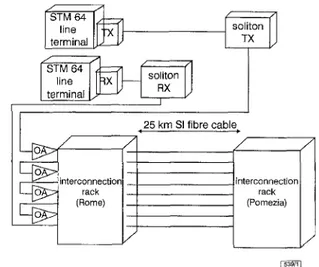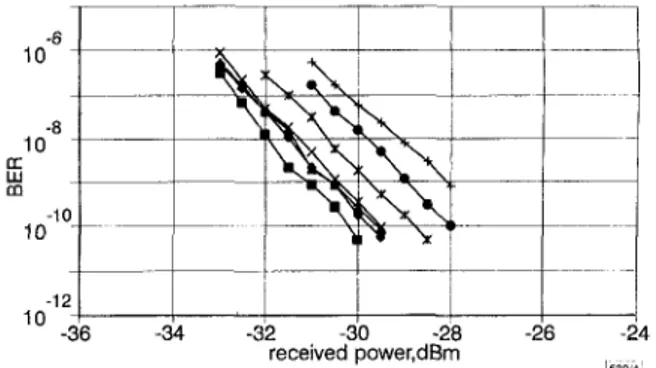vegetable objects (e.g. small pieces of pod), and non-vegetable objects (e.g. small stones). In our experiments, we used two differ- ent RBF neural networks to associate each sample with one of the above classes: one was trained using the k-means clustering algo- rithm for the whole training set (i.e. without considering the class- memberships of the training samples); the other was trained using the proposed technique. The training phase was carried out on 505 samples; the test was performed on another 504 samples, inde- pendently chosen. Several trials were carried out by increasing the number of hidden neurons (and hence the number of kernel func- tions) from 10 to 100 (in steps of five). These trials allowed us to compare the behaviours of the classification errors made by the two training techniques for different numbers of kemel functions. For each trial carried out with the proposed technique, an equal number of kernel functions was chosen for each class.
Fig. 2 shows the classification errors made on the test set with the classical and the proposed techniques. The results confirm that the proposed technique significantly reduces the classification error made by the RBF neural classifier. In particular, the smallest classification error obtained using the classical technique was
14.70% (for 80 hidden units), whereas the minimum classification error obtained with the proposed technique was 13.060/0 (for 70 hidden units).
In addition, Fig. 2 confirms that the classification error incurred by the classical technique shows an oscillatory behaviour with regard to the number of hidden neurons considered (this makes it critical to fix the number of hidden units for an RBF neural classi- fier). On the contrary, the proposed technique results in a more stable trend of the classification error and consequently provides a better framework for choosing the architecture of an RBF neural classifier.
10Gbit/s alternate polarisation soliton
transmission over 300km step-index fibre
link with no in-line control
P. Franco, A. Schiffini, R. Corsini,
M. Romagnoli,
M. Tamburrini
and S. CascelliA straight-line in-field transmission was performed over a 300km step-index fibre link installed between Roma and Pomezia using a 1 OGbiUs stream of 1550nm alternate-polarisation solitons. Standard SDH 10Gbit/s line terminals were used at the transmitter and receiver sides. Error-free transmission was obtained with optical amplifiers placed every 5Okm and with no in-line soliton control. It is important to underline that in this case the large chromatic dispersion was compensated for by fibre non-linearity without resorting to chromatic dispersion compensators.
The growing demand for large capacity communication links raises the problem of the already installed worldwide fibre infra- structure which is mostly constituted by step-index (SI) fibres with zero dispersion at 1.3p-n. So far, dispersion management and/or wavelength division multiplexing (WDM) have been demonstrated to be suitable solutions for upgrading the existing fibre infrastruc- ture. Those solutions require system adjustment, such as the intro- duction of dispersion compensating fibres
or,
in the case ofWDM, an upgrade in terms of the number of channels, instead of simply increasing the capacity of the single channel, which would save in overall transmission bandwidth. In this Letter, we report an optimised transmission scheme which makes it possible to improve the maximum distance achievable on SI fibre with only a single channel, without resorting to the insertion of in-line compo- nents (such as chirped gratings, dispersion-compensating fibres, mid-span phase-conjugators, or even synchronous amplitude or phase modulators). The method simply exploits the reduced inter- action efficiency experienced by orthogonal solitons to increase the duty cycle in the data stream [I], and it is implemented with a polarisation encoder which alternates orthogonal states of polari- sation in the data stream. The effectiveness of alternate polarisa- tion encoding has been theoretically predicted [2] and
Conclusions: We have proposed a simple supervised technique for RBF neural network classifiers. In our experiments, this technique significantly reduced the classification error made by the classifier. In addition, a more stable behaviour of the classification error, with regard to the number of hidden units, was obtained. This renders the selection of the number of hidden units in an RBF net- work a less critical choice.
Acknowledgment: This research was partially supported by Bull HN Information Systems Italy S.p.A.
0 IEE 1998
Electronics Letters Online No: I9980789
L. Bruzzone and D. Fernandez Prieto (Depavtment of Biophysical and Electronic Engineering, University of Genoa, Via Opera Pia I l a , I-
16145 Genova, Italy)
31 March 1998
References
POWEL. M J.D : ‘Radial basis functions for multivariate interpolation: a review’ in MASON. J . C , and cox, M.G. (Eds.): ‘Algorithms for approximation’ (Clarendon Press, Oxford, 1987), pp, 143-167 PHILLIPS, W.J , TOSUNER, c , and ROBERTSON, w.: ‘Speech recognition techniques using RBF networks’. Proc. IEEE WESCANEX 95. Communications, Power, and Computing, New York, USA, 1995,
Vol. 1, pp. 185-190
NUNNARI. G., GALLO, A., REITANO, D., and OCCHIPINTI, L.: ‘Neural nets in fault diagnosis’, Autom. Strum., 1997, 45, (6), pp. 101-108 BISHOP. c.M.: ‘Neural networks for pattern recognition’ (Clarendon Press, Oxford, 1995)
experimentally verified at 40Gbitis over 800km in a dispersion- shifted fibre setup [3]. The maximum transmission distance
achieved with our SI fibre system, based on alternate polarisation encoding, was 300km, thus extending the limit of 253km found with the dispersion supported transmission (DST) technique [4], another method of transmission with no in-line control.
soliton TX
I
I , I
-
1116 ELECTRONICS LETTERS 28th May
7998
Vol. 34 No.I 7
25 km SI fibre cable
-interconnection interconnection
L o rack rack
(Rome) (Pomezia)
m Fig. 1 Line configuration
The line configuration is shown in Fig. 1 , with the experimental setup shown in Fig. 20. The 5GHz soliton pulses emitted by the soliton generator have adjustable duration between 45 and 65ps and
-
-3dBm average power. The pulses are amplified by means of a polarisation maintaining optical amplifier up to 11 dBm and sent to the polarisation encoder.The 10GbiVs electrical data are provided by the STM-64 line terminal whose clock also drives the entire setup. The electrical signal is divided into two 5Gbit/s electrical bit streams by means of the bit divider. The two SGbitis electrical bit streanis are used to modulate the 5GHz optical pulse streams by means of Mach- Zehnder modulators. Finally, the two 5 Gbit/s optical pulse
streams are time-interleaved by introducing a loops differential delay, and combined by means of the polarisation encoder, The output of the whole source is a 1OGbitis pulse train with adjacent time slots having orthogonal polarisation (alternate polarisation encoding). A typical eye diagram is shown in Fig. 3a.
10 G b i t / s . T l data inDut divider 10 GHz clock
input
Gbit/s o d ~ . ’ . .?-+ ^. ..I . .
a
b
Fig. 2 Polarisation encoding source scheme and RZ to NRZ converter’ a Polarisation encoding source scheme
b RZ to NRZ converter
time,ps
a b
Fig. 3 Eye diagram of IOGbit/s orthogonal polarisation coded signul
U At output of transmitter h After 300km
Horizontal scale 2Opddiv
The link is made with a 2Skm cable which also contains 20 SI fibres (ITU-T G6S2), looped back in pairs at a transit station in Pomezia (25km south of Rome) in order to obtain 10 spans of SOkm each. All the terminations of the spans are located in Rome (see Fig. 1). The mean attenuation, chromatic dispersion and polarisation mode dispersion of these fibres are 0.24dB/km, D = 16.2ps/nm/km and PMD = 0.04p~/km~’~, respectively. At each span end we introduced a commercially available optical amplifier with a saturated output power of +14dBm. The maximum polari- sation dependent gain of the amplifiers was PDG = 0.3dB, whereas the maximum differential group delay was DGD = Ips. This configuration, with all the terminations in the same labora- tory, permitted us to check the quality of the transmission after each span of 50km by monitoring the signal just before each amplifier. The soliton pulses at the end of the line were detected by means of an RZ to NRZ converter placed just before the STM- 64 line terminal receiver (Fig. 2h).
The eye diagram obtained after 300km is shown in Fig. 3b. AS
can be seen, with 50ps pulses (the optimal FWHM pulse duration obtained from numerical simulation of performance evaluation) the eye pattem is quite clean up to 300km, while for longer prop- agation distances a good transmission result cannot be obtained. Several parameters were adjusted to obtain the best result: line input power, amplifier gain, and pulse duration.
The bit error rate (BER) measured by the receiver terminal is shown in Fig 4 against the power level at the preamplifier input
-6 10 -8 10 a: W m 1 10 - 1 2 !
1
,j
i
I l o -36 -34 -32 -30 -28 -16-?,
received power,dBmFig. 4 BER mearnrenient resultsfor source back-to-back and after each 50 kin
+
back-to-back W 50 km A100km X 150km % 200 km 0 250km+ 300km
As shown by the BER results, after 200km the power penalty of the system was 1.5dB, and < 3dB after 300km. In this configura- tion, after 300km, a BER. < was achieved with a received optical power of -28dBm. For comparison we also evaluated the system performance with a lOGbit/s BER test set. We noticed that at 300km propagation distance it is possible to reach excellent val- ues of BER measurement down to 1W2 with a 17-1 word length. With the same word length, transmission up to 500km is also fea- sible. These results, obtained with the short word, suggest that the real limitation of the system arises from some pattern effect that is increasingly efficient with increased pattern length. In fact, by resorting to a deterministic data stream, we found that short pat- terns are more stable than longer ones.
Conclusions: We report the longest propagation distance of 300km
obtained at 10GbiVs using a conventional step-index fibre link without any dispersion compensating technique or in-line signal control, but only with optical amplification every 50 km.
Acknowledgments: M. Romagnoli and M. Tamburrini have
performed this work in the framework of the agreement between Fondazione Ugo Bordoni and the Italian Post and Telecommunication Administration. This work has been partially carried out under the ESTHER project of European Union ACTS programme.
0 IEE 1998
Electronics Letters Online No: 19980781
P. Franco, A. Schiffini and R. Corsini (Pi~elli Cnvi & Sistemi, viale
Sarca, 222, 20126 Milano, Italy)
M. Romagnoli and M. Tamburrini (Fondazione Ugo Bordoni, via B.
Castiglione, 59, 00142 Roma, Italy)
S. Cascelli (Istituto Superiore delle Comunicazioni e Tecnologie dell’lnformuzione, vide Euvqpa 190, 00144 Roma, Italy)
I April 1998
References
DE ANGELIS. C., WABNIT‘Z, S., and HAELTERMAN, M.: ‘Bandwidth limits due to polarisation multiplexed soliton interactions’, Electron. Lett., 1993, 29, pp, 1568-1570
MATERA, F., ROMAGNOLI, M., and DAINO, B.: ‘Alternate polarisation soliton transmission in standard dispersion fibre links with no in- line controls’, Electron. Lett., 1995, 31, pp. 1172-1174
DEVAUX, F., and GEORGES, T.: ‘Single-wavelength 40Gbitis, 8 X l0Okm span soliton transmission without any in-line control’, Electron. Lett., 1997, 33, pp. 407408
WEDDING. B , FRANZ, B., and JUNGINGER, B.: ‘IO-Gbis optical transmission up to 253km via standard single mode fiber using the method of dispersion supported transmission’, J. Lightwave Technol., 1994, 12, pp. 1720-1727
FAVRE, F., LE GUEN, D., MIOULINARD, M.L., HENRY, M., FRANCOIS, P.L.,
ELECTRONICS LETTERS 28th May 7998 Vol. 34 No. 71 1117

